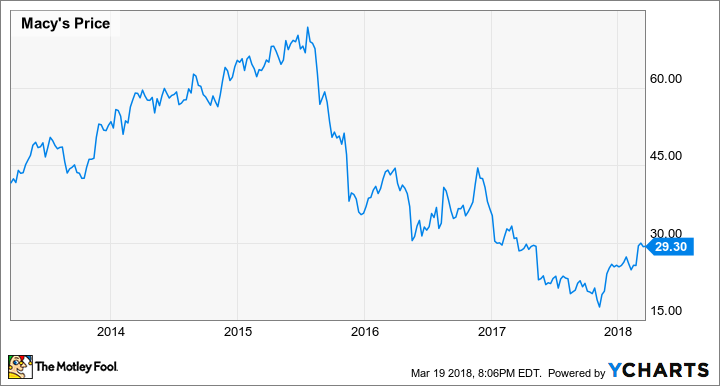In recent years, Macy's (M 3.06%) has developed a very clear capital allocation policy. The company's main priorities are to make necessary investments in its business and to maintain its quarterly dividend of 37.75 cents per share. Those two items average roughly $1.4 billion to $1.5 billion per year.
Excess cash flow is used for share buybacks -- but only if leverage is within Macy's target range of 2.5 to 2.8 times adjusted earnings before interest, taxes, depreciation, amortization, and rent (EBITDAR). (Confusingly, Macy's refers to this metric as adjusted EBITDA.) If leverage is above Macy's target range, the company instead uses its extra cash to pay down debt.

Macy's tries to keep its financial leverage within a tight range. Image source: Macy's.
This policy may seem sensible enough. However, the result is that Macy's tend to spend money on share repurchases only when the stock is flying high, ensuring that it gets less bang for the buck.
Cyclical share buybacks
Macy's earnings power reached a peak between 2012 and 2014. Adjusted EBITDAR exceeded $4 billion in each of those years. Macy's strong earnings recovery after the Great Recession caused leverage to fall to the lower boundary of its target range.
In response, Macy's deliberately increased its debt by more than $400 million between early 2013 and early 2015 in order to keep its debt from falling below 2.4 times adjusted EBITDAR. This fueled a share buyback binge. Between 2013 and 2015, Macy's spent $5.5 billion buying back stock at an average price of nearly $55/share, almost twice the current share price.
Macy's Stock Performance, data by YCharts.
Macy's slowed its share repurchase program dramatically during fiscal 2016. At the beginning of that year, Macy's leverage ratio was already above its target, at 3.0 times adjusted EBITDAR. By the end of fiscal 2016, debt had reached 3.3 times adjusted EBITDAR, as the company's earnings power deteriorated further.
As a result, in February 2017, Macy's management suspended share buybacks indefinitely. Even as Macy's stock plunged below $30 -- and then below $20 -- Macy's stuck with its commitment to use all of its excess cash to pay down debt.
Macy's is sticking with its debt reduction focus
This single-minded focus on paying down debt has been effective. Macy's reduced its debt by $988 million over the course of fiscal 2017. Meanwhile, the company stabilized its profitability. By the end of the year, adjusted debt was 2.9 times adjusted EBITDAR (excluding a one-time gain from the sale of a store in downtown San Francisco).
Last month, I argued that Macy's would probably be able to restart its share repurchase program this year, as the company would soon reach its leverage target. Indeed, Macy's had nearly $1.5 billion of cash and investments on its balance sheet at the end of fiscal 2017. It could reach its leverage target immediately by using $400 million to pay down some more debt. This would still leave the company with an ample cash cushion.
Instead, CFO Karen Hoguet indicated during Macy's earnings call last month that the company is likely to continue using all of its excess cash (beyond what is needed for capex and dividends) to reduce its debt load. Share repurchases will probably have to wait until fiscal 2019 or thereafter.
A balanced approach makes more sense
There's nothing inherently wrong with debt reduction. Given the upheaval that department stores are facing today, it probably makes sense for Macy's to continue reducing its debt load.
The problem is Macy's mechanistic approach to capital allocation -- which is further aggravated by the tight range of its leverage target. When earnings rise, Macy's leverage ratio declines, driving the company to buy back lots of stock. But that's exactly when the stock price is likely to be at its highest levels. On the flip side, earnings slumps force Macy's to focus on debt reduction just when the stock tends to be bottoming out.
Instead, Macy's should reduce its debt to a new target over a period of several years, while retaining flexibility to vary the mix of share buybacks and debt repurchases during that period. This would allow Macy's to capitalize on pullbacks in its share price by buying back more stock. That makes a whole lot more sense than its current plan, which amounts to a "buy high" strategy for share repurchases.







